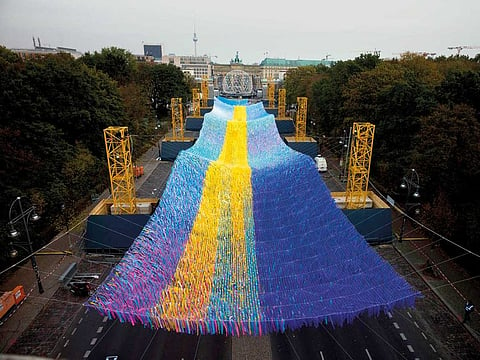The Wall has years
Visitors to Berlin are being invited to feel the Peaceful Revolution with unique events

Two generations have come of age in a newly reunified Germany — the children of tomorrow, as the Scorpions referred to them in their epic smash, Wind of Change.
With more than 200 events this week, Germany’s historic capital will attempt to take residents and visitors back to the magic of the moment, to that glory night when the Berlin Wall, history’s most divisive border, was breached in the Peaceful Revolution of 1989.
A host of special events this week will attempt to recreate the feeling of that moment 30 years ago. Berlin will be transformed into an open-air exhibition and festival venue until November 10, with activities at seven city locations that are inseparably linked to the revolution.
Commemorative highlights include a large-scale art installation and a stage show on the evening of November 9, both at the iconic Brandenburg Gate, 3D video projections on to building facades around the city, seven open-air exhibitions and augmented reality experiences.
Visitors around the world will be able to celebrate alongside, with several experiences now accessible online.
“The fall of the wall on November 9 is one of the happiest moments, if not the happiest moment, in recent German history, with a worldwide impact by bringing the confrontation between the Eastern and Western blocs to a close and preparing the ground for a united Europe,” Simone Leimbach, Project Head, 30 Years Peaceful Revolution — Fall of the Wall at organisers Kulturprojekte Berlin, tells GN Focus. “It has become a symbol for freedom worldwide.
History is written in everyday places and by very different people. That is still as relevant today as it was back then. We therefore want the visitors to take part in the celebrations, but also to learn about the past events and discuss their relevance for the present and the future.

“The actions of the courageous citizens of East Germany who stood up for freedom, democracy and human rights made the impossible possible, and they did so peacefully. This is something that still inspires us today and can give people the strength to engage with the challenges facing us today and in the future.
“History is written in everyday places and by very different people. That is still as relevant today as it was back then. We therefore want the visitors to take part in the celebrations, but also to learn about the past events and discuss their relevance for the present and the future.”
In particular, visitors to the city should look up to the skies. Inspired by protesters who raised banners to demand a more democratic future, 30,000 people in Berlin and worldwide were asked to think about their memories of these past events, as well as their wishes and visions for the future. These messages, written on 30,000 ribbons, are part of Patrick Shearn’s Visions in Motion.
Curated by Kulturprojekte Berlin, the hand-crafted artwork floats in the skies above Berlin this week, spanning the 100 metres over the Straße des 17 Juni towards the iconic Brandenburg Gate.
Global participation
People in the UAE and other parts of the world can send personal messages to the city at Mauerfall30.berlin; these will be projected at the Gate throughout the week.
For those who actually want to experience what life in divided Berlin was like, the augmented reality (AR) app MauAR will bring the now mostly disappeared wall to life on smartphones, taking users on a journey through time and to some important episodes of the Peaceful Revolution. Anyone worldwide can view them at Mauar.berlin.
About 30 other historic moments will be brought to life via AR. Developed by Facebook and ZDF digital, they can be accessed online via Facebook messenger at M.me/mauerfall30.
Finally, Saturday’s commemorative stage show at the Brandenburg Gate will be streamed online and broadcast on TV. The two-hour event will feature a talk with civil rights activists about Germany’s history of freedom, but there will also be light shows and musical performances by the Berlin State Opera, conducted by Daniel Barenboim, by musicians born in the former GDR, as well as younger acts who will seek to express how they have experienced life after the Wind of Change swept across a newly reunified Berlin.
Stronger together
When the physical and ideological wall between East and West Berlin was breached on November 9, 1989, few had a clear idea of just how far the new nation would come.
Thanks to a number of factors, not least the formation of the Eurozone, the greatest impact has been economic. Germany is now the fourth-largest country by GDP at $4.4 trillion (Dh16.16 trillion) in 2019 and an engine of global economic growth. At the time of reunification, the former GDR contributed just 8 per cent to the new nation’s GDP; today those regions are only about 15 per cent behind their western counterparts, Reint Gropp, the director of the IWH economic think tank in Halle, told the Financial Times. This is thanks in large part to a rise in infrastructure and industrial investment.
Although the economic gap between the two areas has yet to equalise, the convergence in living standards has evolved satisfactorily. By the 25th anniversary of reunification in 2014, disposable per capita income in the former East was 82 per cent of the western level, and the gap has continued to close in the past five years. In another 30 years, any differences will hopefully have entirely disappeared.
— K.J.F.
Sign up for the Daily Briefing
Get the latest news and updates straight to your inbox



